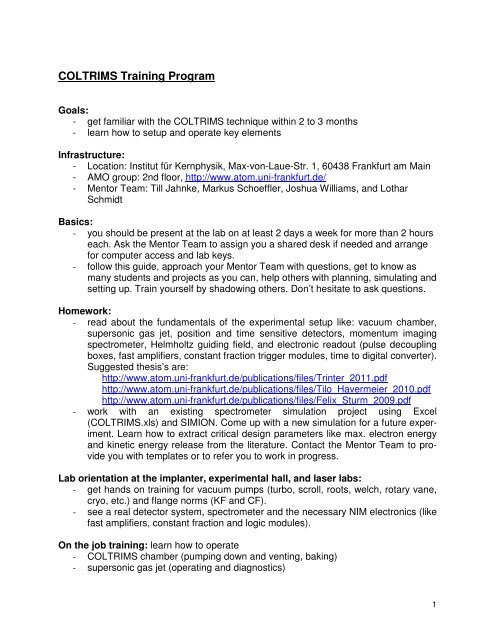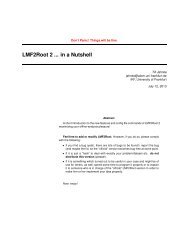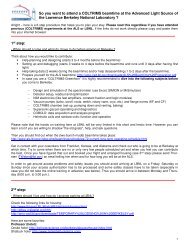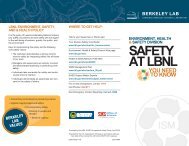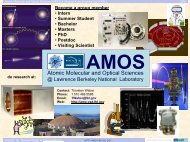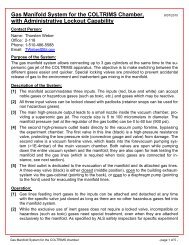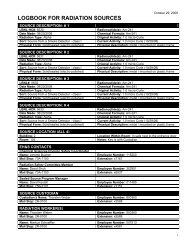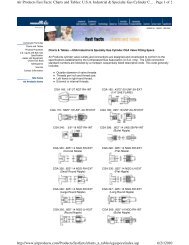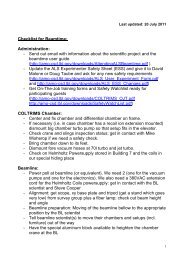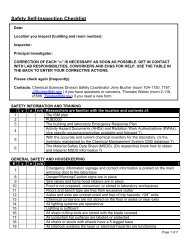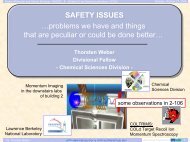COLTRIMS Training Program at the University of Frankfurt
COLTRIMS Training Program at the University of Frankfurt
COLTRIMS Training Program at the University of Frankfurt
You also want an ePaper? Increase the reach of your titles
YUMPU automatically turns print PDFs into web optimized ePapers that Google loves.
<strong>COLTRIMS</strong> <strong>Training</strong> <strong>Program</strong><br />
Goals:<br />
- get familiar with <strong>the</strong> <strong>COLTRIMS</strong> technique within 2 to 3 months<br />
- learn how to setup and oper<strong>at</strong>e key elements<br />
Infrastructure:<br />
- Loc<strong>at</strong>ion: Institut für Kernphysik, Max-von-Laue-Str. 1, 60438 <strong>Frankfurt</strong> am Main<br />
- AMO group: 2nd floor, http://www.<strong>at</strong>om.uni-frankfurt.de/<br />
- Mentor Team: Till Jahnke, Markus Schoeffler, Joshua Williams, and Lothar<br />
Schmidt<br />
Basics:<br />
- you should be present <strong>at</strong> <strong>the</strong> lab on <strong>at</strong> least 2 days a week for more than 2 hours<br />
each. Ask <strong>the</strong> Mentor Team to assign you a shared desk if needed and arrange<br />
for computer access and lab keys.<br />
- follow this guide, approach your Mentor Team with questions, get to know as<br />
many students and projects as you can, help o<strong>the</strong>rs with planning, simul<strong>at</strong>ing and<br />
setting up. Train yourself by shadowing o<strong>the</strong>rs. Don’t hesit<strong>at</strong>e to ask questions.<br />
Homework:<br />
- read about <strong>the</strong> fundamentals <strong>of</strong> <strong>the</strong> experimental setup like: vacuum chamber,<br />
supersonic gas jet, position and time sensitive detectors, momentum imaging<br />
spectrometer, Helmholtz guiding field, and electronic readout (pulse decoupling<br />
boxes, fast amplifiers, constant fraction trigger modules, time to digital converter).<br />
Suggested <strong>the</strong>sis’s are:<br />
http://www.<strong>at</strong>om.uni-frankfurt.de/public<strong>at</strong>ions/files/Trinter_2011.pdf<br />
http://www.<strong>at</strong>om.uni-frankfurt.de/public<strong>at</strong>ions/files/Tilo_Havermeier_2010.pdf<br />
http://www.<strong>at</strong>om.uni-frankfurt.de/public<strong>at</strong>ions/files/Felix_Sturm_2009.pdf<br />
- work with an existing spectrometer simul<strong>at</strong>ion project using Excel<br />
(<strong>COLTRIMS</strong>.xls) and SIMION. Come up with a new simul<strong>at</strong>ion for a future experiment.<br />
Learn how to extract critical design parameters like max. electron energy<br />
and kinetic energy release from <strong>the</strong> liter<strong>at</strong>ure. Contact <strong>the</strong> Mentor Team to provide<br />
you with templ<strong>at</strong>es or to refer you to work in progress.<br />
Lab orient<strong>at</strong>ion <strong>at</strong> <strong>the</strong> implanter, experimental hall, and laser labs:<br />
- get hands on training for vacuum pumps (turbo, scroll, roots, welch, rotary vane,<br />
cryo, etc.) and flange norms (KF and CF).<br />
- see a real detector system, spectrometer and <strong>the</strong> necessary NIM electronics (like<br />
fast amplifiers, constant fraction and logic modules).<br />
On <strong>the</strong> job training: learn how to oper<strong>at</strong>e<br />
- <strong>COLTRIMS</strong> chamber (pumping down and venting, baking)<br />
- supersonic gas jet (oper<strong>at</strong>ing and diagnostics)<br />
1
- detectors (power-on, pulse decoupling, monitoring, trouble shooting, pulse processing<br />
& adjustment <strong>of</strong> <strong>the</strong> electronics). Carry out <strong>the</strong> lab-training course “V24<br />
Ionen-Impulsspektroskopie” <strong>at</strong> <strong>the</strong> IKF, lab 1.307 (contact person: Lothar<br />
Schmidt, schmidt@<strong>at</strong>om.uni-frankfurt.de).<br />
- COBOLD: d<strong>at</strong>a acquisition and analysis program (file structure, change parameter<br />
files, view and project spectra, interpret crucial spectra like, CNT, hitp<strong>at</strong>tern,<br />
timesum vs layer, fish, wiggle, TOF, PIPICO” etc., add new spectra and parameters)<br />
Extra: D<strong>at</strong>a analysis<br />
- if time permits, learn how to presort list-mode d<strong>at</strong>a files and read <strong>the</strong>m with<br />
ROOT.<br />
2


